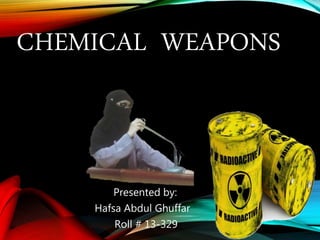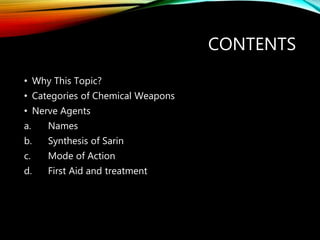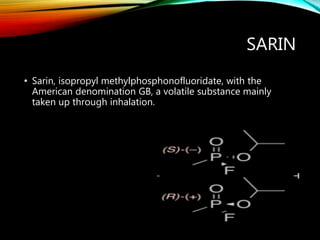Chemical weapons
- 1. CHEMICAL WEAPONS Presented by: Hafsa Abdul Ghuffar Roll # 13-329
- 2. CONTENTS âĒ Why This Topic? âĒ Categories of Chemical Weapons âĒ Nerve Agents a. Names b. Synthesis of Sarin c. Mode of Action d. First Aid and treatment
- 4. CHEMICAL WEAPONS âĒ A toxic chemical contained in a delivery system, such as a bomb or shell. âĒ According to Chemical Weapons Convention CWC, the term chemical weapon is applied to any toxic chemical or its precursor that can cause death, injury, temporary incapacitation or sensory irritation through its chemical action. âĒ Munitions or other delivery devices designed to deliver chemical weapons, whether filled or unfilled, are also considered weapons themselves.
- 5. CATEGORIES Military planners generally organize chemical into four groups: âĒ 1- nerve agents (such as sarin and VX) âĒ 2 -blister agents (such as mustard gas) âĒ 3-choking agents (such as chlorine and phosgene) âĒ 4- blood agents (such as hydrogen cyanide).
- 6. BLOOD AGENTS âĒ Volatile, flammable, usually colorless gasses attack by being absorbed in blood âĒ Are cyanide or arsenic based âĒ act through inhalation âĒ Inhibit cellsâ ability to transfer or utilize oxygen Arsine
- 7. CHOCKING AGENTS âĒ Attack on lungs and eyes. âĒ Injure victims through inhalation and have a mild effect on skin. âĒ Are gasses with specific odour. âĒ Chlorine gas and phosgene âĒ Low boiling points Phosgene
- 8. BLISTERING AGENTS âĒ A blister agent, or vesicant, is a chemical compound that causes severe skin, eye and mucosal pain and irritation. âĒ Chemically belong to these categories: 1. Sulfur mustards â A family of sulfur-based agents, including mustard gas. 2. Nitrogen mustards â A family of agents similar to the sulfur mustards, but based on nitrogen instead of sulfur.
- 10. NERVE AGENTS âĒ phosphorus-containing organic chemicals (organophosphates) that disrupt the mechanisms by which nerves transfer messages to organs.
- 11. TABUN âĒ Tabun, O-ethyl dimethylamidophosphorylcyanide, with the American denomination GA.
- 12. SOMAN âĒ âĒ Soman, pinacolyl methylphosphonofluoridate, with the American denomination GD, a moderately volatile substance which can be taken up by inhalation or skin contact.
- 13. SARIN âĒ Sarin, isopropyl methylphosphonofluoridate, with the American denomination GB, a volatile substance mainly taken up through inhalation.
- 14. SYNTHESIS âĒ Reaction of methylphosphonyl difluoride with isopropyl alcohol, which produces hydrofluoric acid as a byproduct:
- 15. SYNTHESIS âĒ By reaction of equal quantities of methylphosphonyl difluoride and methylphosphonic dichloride
- 16. NERVE AGENTS SLUDGE Syndrome âĒ Salivation âĒ Lacrimation (tears flow) âĒ Urination âĒ Diaphoresis (sweating) âĒ Gastrointestinal motility âĒ Emesis (vomiting)
- 18. MODE OF ACTION âĒ irreversibly inhibit enzyme acetylcholinesterase. âĒ If nerve agent is inhaled poisoning effects start immediately âĒ If nerve agent gets into body via skin it might take 20-30 minutes for the symptoms to appear.
- 20. MODE OF ACTION Normal Reaction âĒ Enzyme-OH + CH3C(=O)-O-(CH2)2-N+(CH3)3 -------ï Enzyme-O-C(=O)-CH3 + choline âĒ Enzyme-O-C(=O)-CH3 -----â Enzyme-OH + CH3COOH (hydrolysis) Nerve Agent âĒ Enzyme-OH---X-P(=O)(R1)(-OR2) releases X- to give Enzyme-O- P(=O)(R1)(-OR2)
- 21. TREATMENT Reactivation Using Oxime âĒ The oxime (Pralidoxime in given example) attacks the P-O bond âĒ operational enzyme and a phosphorylated oxime, which is rapidly hydrolyzed to non-toxic products, are formed
- 22. TREATMENT âĒ Ageing âĒ In the "ageing" reaction, the phosphorylated enzyme is dealkylated âĒ Enzyme-O-P(=O)(R1)(-OR2) reacts to give Enzyme-O- P(=O)(R1)-OH âĒ The reaction is catalyzed by the enzyme itself âĒ Reaction may be extremely fast. âĒ Soman-inhibited acetylcholinesterase becomes "aged" within a few minutes.























